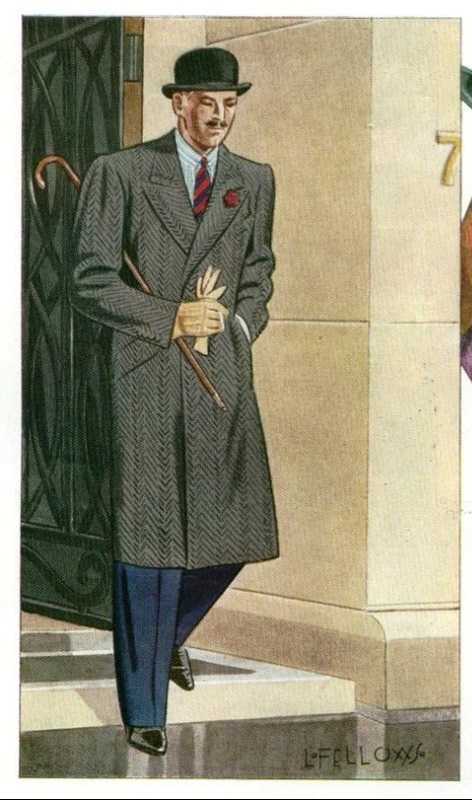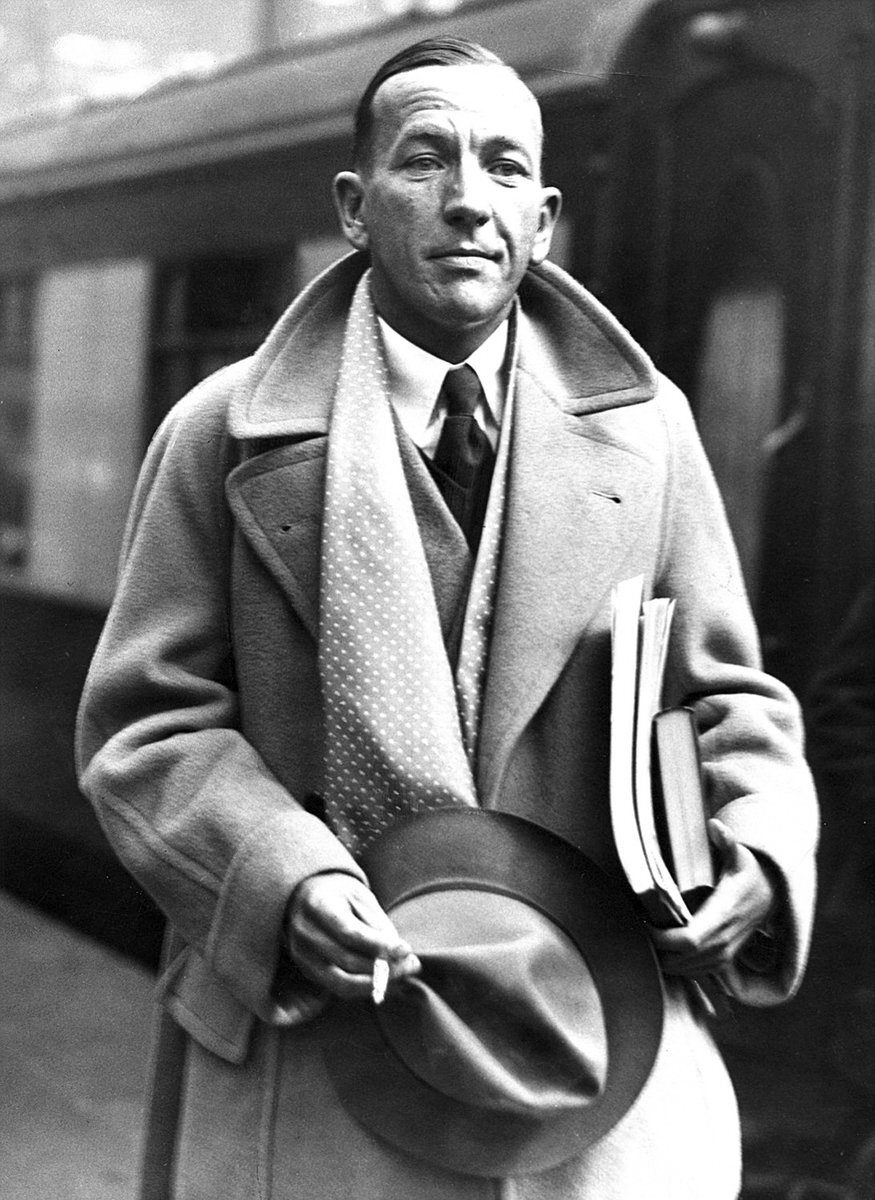It is that time of year again: the leaves have fallen off the trees, the skies are darkening early and there may even be snow on the ground. You open the cupboard and pull out your winter coat. What does it look like? A camel hair polo coat? Raglan sleeved tweed? Well tailored city coat in grey cashmere? You probably don’t have the one that you really want, and equally probably, you have put off replacing your tried and trusty coat year after year.
Obtaining a new one is not easy. Winter coats can represent a serious investment, so it is worth running through the possibilities. We are talking here about coats for wearing over suits and jackets, not padded jackets or pea coats.
1. Top coat or overcoat
The traditional “dress” coat, suitable for the office, elegant and fairly formal:

Note the length – below the knees. Any shorter and your legs will be cold and wet under the coat. Made of wool or cashmere (or a wool-cashmere blend), this type of coat can be single or double-breasted, and sometimes has a velvet or fur collar (in which case, you call it a Chesterfield, named after Lord Chesterfield, who popularised it in the 19th century). Usually in a sombre shade (charcoal or navy) this coat will keep you warm and dry, and will help you to stand out. If you are thinking of having a top coat tailored, insist on wool that weighs at least 25 oz per running metre. If you are thinking of cashmere, the coat will look nice and shiny, and will feel soft to the touch, but it will probably not wear as well as plain wool.
2. Polo coat
This coat was originally made for polo players to wear between chukkas. A casual coat, best in a light colour, will serve as well as a traditional top coat. Polo coats are double breasted, have flapped patch pockets, wide lapels and a half belt at the back. If your polo coat has a belt in front, it should be tied, not fastened. The ideal polo coat comes down a couple of inches below the knee, a bit longer than what you see in the picture. Also, note the turned back cuffs.

Materials? Camel hair looks fantastic, but is extremely expensive and does not wear as well as wool (particularly around the cuffs). Some mills make a camel-wool or camel-nylon blend (the latter for water proofing), which are a little tougher than plain camel. Alternatively, thick melton wool in camel colour or a light grey will work just as well, but shades should be plain.
3. Casual overcoat
Similar to the polo coat, but with raglan sleeves, a casual overcoat may or may not have a belt, and can be single or double breasted. The shoulders, named after Lord Raglan, a 19th century English general, have plenty of room and tell you that this coat is for weekends or casual evenings.
4. Trench coats
Trench coats are rain coats. You might wear one in the winter when a winter overcoat is unnecessary, but trench coats are strictly for the rain – and in fact for all seasons.
5. Duffle coats
The duffle coat is possibly best known for being a favourite of sailors, often in camel hair. Thick (rather blankety), very warm, mid-length and with signature wooden or bone hooks, not buttons, patch pockets and a hood, the duffle coat is strictly casual.
The duffle coat is made of duffel, taking its name from a village in Belgiam, Duffelzandhoven. Originally black wool, the fabric was used for luggage and blankets, and has been woven since the 17th century. It was originally worn by French naval officers. From there it was taken up by the Royal Navy, thence to civilian use. Word has it that after WWII there were thousands of leftover coats, sold at knock-down prices to civilians, particularly students.
The reason for the toggles, rather than buttons, is lost to myth, but some sources have it that it was easier to fasten in very cold weather when wearing gloves than it would have been had buttons been used. Whatever the truth, the story is a good one.
Fabrics for the winter
In the paragraphs above, we mentioned a few fabrics – melton wool, camel hair, cashmere. Let’s get into a little more detail.
Camel hair (or more correctly, camel wool) is made from the hair of the Bactrian camel (two humps and lives in Asia). These camels have two hair coats – an undercoat and an overcoat, or outer coat. The outer hair, or guard hair, is fairly rough, but the undercoat hair is soft and supple.
Conversely, a Bactrian camel’s undercoat is extremely soft, so it is used for making clothes. The purpose of the undercoat is to insulate the camel, making it ideal for the winter. The grade of camel hair depends on the fineness of the hair. High-grade camel hair is the finest hair in the camel’s undercoat. This is used for the best camel hair fabric. Medium-grade hair is also from the undercoat, but is rougher than high-grade hair. Low-grade camel hair is rough, and better used for carpets and furnishings, rather than for clothing.
Camel hair is processed in much the same way as other types of animal hair (e.g, sheep) to produce what is in fact wool. If you are concerned about sustainability, don’t be: camels shed their hair naturally so no shearing is required.
Wool, by which we mean wool made from the fleece of sheep, needs little or no introduction. For the winter, you want to think about the heaviest weights. We have already mentioned duffel wool. Similar in terms of texture and feel is melton wool, often used for winter coats. Melton is probably the thickest wool weave that you can find. It comes from the English village of Melton Mowbray, and is actually a variation on twill, heavily fulled to make it thicker and remove oil and dirt. Originally, fulling meant beating the wool with a club; nowadays it is scoured and milled by machines, to make it thick and similar to felt, but much stronger. It wears very well, keeps you warm and is virtually waterproof.
Cashmere is common in formal winter overcoats; the question is, how is it woven? Cashmere is a type of wool or more correctly hair, from Mongolian goats. It can be woven in a melange, a soft rather blankety weave. Some makers offer cashmere – wool blends, and this is recommended because cashmere does not stand up well to wear and tear.
Tweed is well known for casual winter coats; a good thick Harris tweed or covert cloth will give you many years of warmth and protection from the elements.
Equally suitable are heavy weight worsted wools and gabardine. As we wrote above, ask for the heaviest weights. Because an overcoat is worn outside everything else, it tends to get more wear than a suit would, so the cloth must be as tough as possible.
Colours
The colour of your coat depends on where you are going to wear it, and when. Obviously, camel hair is light brown, so if you opt for a camel polo coat, for example, the colour is pretty much fixed. Other coats – such as the Chesterfield, can be made in any colour but we recommend dark blue or dark grey for the office and evening,
For the day time, a muted herringbone would do (a wide herringbone), and for casual wear, browns, tans and checks are fine (but nothing too loud).
What to think about when buying a coat
When working out the details with the tailor, or when shopping for a ready-to-wear coat, keep the following in mind:
The weather – how cold is it, and thus what kind of fabric will be most useful? In addition, think about rain. Will you be wearing the coat in heavy rainfall, or is the weather fairly dry? Dry weather tends to be more bearable than wet weather, and gives you more options for fabric.
Where you will wear the coat – is it for the office, weekends, vacations? A grey raglan sleeved overcoat could probably do for all occasions, but a brown or check coat will not. If you are thinking of a winter coat for wearing out in the evenings you can consider something a little more radical, because of the occasion.
Length – most winter coats available today are fairly short by traditional standards. Coats that do not go below the knees are not very useful because your legs will be cold and mud and rain will destroy your trousers. This leaves MTM or bespoke as your only realistic options.
How much you want to spend – this is the bottom line question. Spending too much is wasteful, but spending too little is an invitation to spending more, later. A cheap winter coat will last you for a season, will not keep you very warm, will not fit well and you will probably not want to wear it. Spend a bit more to get something that you will not need to replace. If you can go for bespoke, we suggest doing so simply because it works out as more cost-effective in the long run.
Caring for your coat
Your winter coat will, if it is well made and of good quality fabric, be a life-long asset and your children and grandchildren will enjoy wearing it. It is not unusual for a good winter coat to last well over 50 years, if worn carefully and cared for. Avoid frequent dry cleaning. If your coat catches mud, hang it up and scrape off the mud when it has dried. Brush it to remove any loose dirt and only dry clean it once a year, if that.
Well said, but all your examples are from 50 or more years ago. Unfortunately, it is near impossible to find a long overcoat of any kind, including duffle, in today’s production. All makers make short coats. It is very rare to find something at knee length or longer.
That is true Sage, here at AskOkey we create bespoke tailoring the way it should be. We’re launching our AskOkey Overcoats very soon, all in a very classic length beyond the knee. Stay tuned on our socials for updates and new releases!
Best,